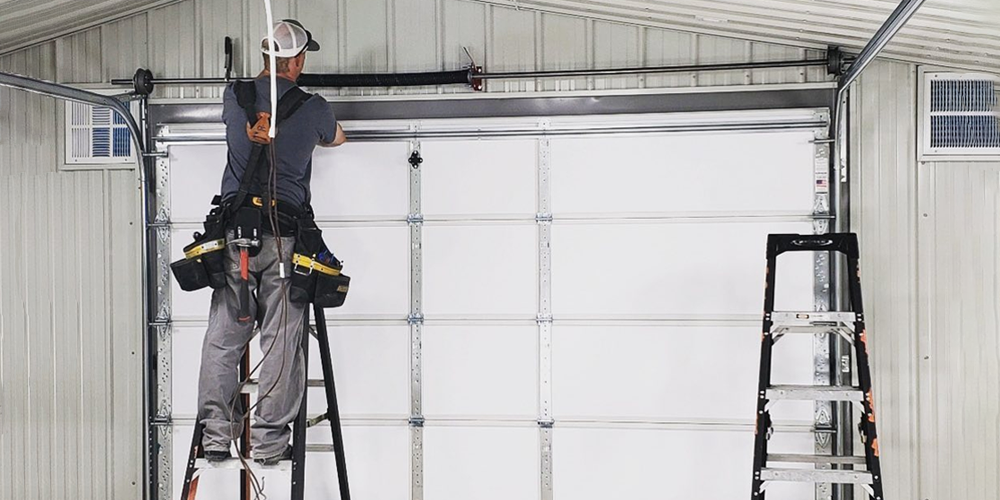Typical Garage Door Troubles and Just How to Fix Them
Garage doors are crucial for both safety and security and benefit, yet they usually present a selection of typical concerns that can annoy homeowners. While some concerns may show up simple to resolve, others may need a more nuanced understanding of garage door mechanics.
Noisy Garage Door Procedure
A noisy garage door operation can be a considerable source of nuisance for homeowners, typically indicating underlying mechanical concerns. Such disruptions might stem from different causes, including damaged rollers, loose hardware, or not enough lubrication. Recognizing the resource of the sound is critical for effective resolution.
One common source of too much noise is the presence of rusty or worn-out rollers. In time, these components can weaken, leading to grinding or squeaking noises as the door actions. Regular assessment and replacement of these rollers can dramatically lower sound levels. Furthermore, loose bolts or screws in the door mechanism can create rattling audios during procedure. Tightening these bolts makes certain an extra stable and quieter activity.
Another contributing element is poor lubrication of the door's moving components. Using a high-grade lube to the tracks, springtimes, and rollers can substantially lessen friction and noise. Property owners need to execute this upkeep regularly to keep optimum performance.
Finally, the garage door opener may likewise generate noise because of its age or mechanical concerns. If the sound lingers in spite of dealing with other variables, consulting a professional for a complete assessment and potential fixing might be required.
Door Won't Open or Close
Experiencing a garage door that won't open up or close can be unbelievably aggravating and frequently signals a breakdown within the system. Numerous elements can add to this issue, and recognizing the origin is important for effective resolution.

Following, evaluate the security sensing units situated at the base of the door. These sensors can end up being misaligned or blocked by debris, avoiding the door from operating appropriately. Tidy the sensors with a soft cloth and ensure they are straightened.
Additionally, the garage door's internal parts must be assessed. Concerns such as a broken springtime, worn-out rollers, or a harmed opener can impede movement. If any parts seem damaged, it might be advisable to get in touch with an expert for fixings.
Misaligned Tracks
(Affordable Excellence)Misaligned tracks can severely interrupt the smooth procedure of a garage door, bring about operational failings such as irregular motion or total immobilization. This issue commonly develops because of a selection of elements, including damage, unexpected effects, or inappropriate installation. When the tracks are misaligned, the rollers can not move freely, which not only strains the electric motor however additionally postures safety and security threats.
If you discover any kind of inconsistencies, it is crucial to resolve the concern immediately. Very carefully touch the track back into its correct setting using a rubber club or a similar tool, ensuring it is straight and degree.
When the placement is remedied, retighten the screws to protect the track. For an extra irreversible service, take into consideration strengthening the tracks with additional braces. Regular maintenance, including cleaning the tracks and making sure rollers remain in good condition, can protect against future imbalances. By resolving misaligned tracks quickly, you can bring back the capability of your garage door and improve its durability.
Broken Springs
Amongst the various parts of a garage door system, busted springtimes are one of one of the most common issues that can dramatically hinder its capability. Garage door springs are crucial for balancing the weight of the door, permitting smooth opening and closing. When a spring breaks, it can lead to a door that is difficult to operate or, in many cases, totally inoperable.
There are 2 primary types of springs: torsion springtimes, which are mounted over the door, and expansion springs, located on either side. Indications of a broken springtime consist of a door that will not open up, a visible space in the spring, or a loud sound throughout operation. Trying to run a garage door with a broken spring can create further damage to the door or the opener.
Fixing busted springs is not a do it yourself project; it requires specialized devices and know-how as a result of the high tension entailed. It is a good idea to get in touch with an expert technician who can securely replace the springs and guarantee the door is properly stabilized. Regular maintenance and examinations can help stop springtime failures and extend the life-span of the garage door system.
Remote Control Issues

The primary step is to inspect the batteries in the push-button control. Replace them if they are weak or dead. If the remote still fails to run, evaluate the garage door opener to guarantee that its sensors are tidy and unblocked. Dust, debris, or misalignment may impede the signal transmission between the remote and the opener.
Interference from various other digital tools can likewise hamper remote capability. Guarantee that close-by devices, such as cordless routers or cordless phones, are not causing disruptions. garage door service. If interference is presumed, attempt relocating these tools better far from the garage door opener
In many cases, the remote may need to be reprogrammed. Speak with the producer's guidelines to reset the remote control and integrate it with the garage door opener. If all else fails and the remote check remains to malfunction, consider speaking with an expert specialist for a detailed assessment and prospective substitute of the remote or opener.
Final Thought
(Affordable Excellence)In recap, usual garage door problems can considerably affect functionality and safety. Resolving loud procedure includes lubrication and tightening hardware, while concerns with opening or closing require assessment of power sources and sensing units. Misaligned tracks can be fixed with change, although busted springs necessitate professional intervention. Remote control breakdowns usually arise from weak batteries or interference, which can be settled with substitute or reprogramming. Positive maintenance and timely fixings can guarantee optimal performance and longevity of garage doors.